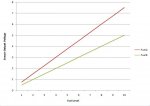I need a better way to measure fuel level in my gas tank.
Presently, I use a capacitive probe in a semi-clear plastic tank. It's a great system but has one drawback -- different gasoline mixes have different effects on the probe, so I have to re-calibrate the probe whenever I change gasoline types -- the two extremes being 100 octane low-lead on the one hand, and 87 octane with up to 15% alcohol on the other.
I'm wondering if there isn't some way to measure fuel level from *outside* of the tank, since the tank is translucent and non-metallic. Any thoughts very welcome.
Presently, I use a capacitive probe in a semi-clear plastic tank. It's a great system but has one drawback -- different gasoline mixes have different effects on the probe, so I have to re-calibrate the probe whenever I change gasoline types -- the two extremes being 100 octane low-lead on the one hand, and 87 octane with up to 15% alcohol on the other.
I'm wondering if there isn't some way to measure fuel level from *outside* of the tank, since the tank is translucent and non-metallic. Any thoughts very welcome.

.jpg)
.jpg)
